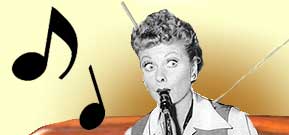 |
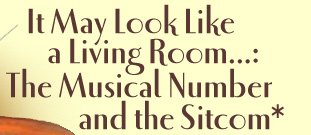 |
 |
|
 |
|
Robynn J. Stilwell
Georgetown University
Printable
Version
PDF, 216K
- They are images firmly established in the common television consciousness
of most Americans: Lucy and Ethel stuffing chocolates in their mouths
and clothing as they fall hopelessly behind at a confectionary conveyor
belt, a sunburned Lucy trying to model a tweed suit, Lucy getting
soused on Vitameatavegemin on live television—classic slapstick
moments. But what was I Love Lucy about? It was about
Lucy trying to “get in the show,” meaning her husband’s
nightclub act in the first instance, and, in a pinch, anything
else even remotely resembling show business. In The Dick Van
Dyke Show, Rob Petrie is also in show business, and though
his wife, Laura, shows no real desire to “get
in the show,” Mary Tyler Moore is given ample opportunity to display
her not-insignificant talent for singing and dancing—as are the
other cast members—usually in the Petries’ living room.
The idealized family home is transformed into, or rather revealed to
be, a space of display and performance.
- These shows, two of the most enduring situation comedies (“sitcoms”)
in American television history, feature musical numbers in many episodes.
The musical number in television situation comedy is a perhaps surprisingly
prevalent phenomenon. In her introduction to genre studies, Jane Feuer
uses the example of Indians in Westerns as the sort of surface element
that might belong to a genre, even though not every example of the genre
might exhibit that element: not every Western has Indians, but Indians
are still paradigmatic of the genre (Feuer, “Genre Study”
139). Musical numbers might be considered the “Indians”
of sitcoms. Like Indians in Westerns, musical numbers in sitcoms may
represent something other than their face value, and attitudes toward
them also change over time.1
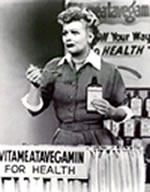 Lucy samples Vitameatavegamin
Lucy samples Vitameatavegamin
- I Love Lucy (1951–1957) and The Dick Van Dyke Show
(1961–1966) present musical numbers in quite different ways, and
although their “situations” were more amenable to the insertion
of musical performance than other sitcoms, the musical number was and
still is a common feature of the sitcom genre. How does this fit in
with theories of the sitcom, not to mention theories of the musical?
What challenge does it pose to genre studies when the primary marker
of one genre persistently shows up as a feature of another? How does
the musical number function within the contemporary culture, and what
are the ramifications of “classicism,” memory, and perpetual
reruns? How has the musical number persisted in the genre?
- The first part of this article will concentrate
on I Love Lucy and The Dick Van Dyke Show, looking
in depth at the musical number’s function both within the show
itself and in the larger context of entertainment and society. For all
their differences, these two sitcoms still, in many respects, set benchmarks
for the genre today—in a 2002 TV Guide “Top
50,” for instance, they were listed as the #2 and #13 all-time
best shows, respectively—and as such demand close attention as
“foundational texts.”2 The
second part of the article will examine the shifting status and significance
of musical numbers in sitcoms through the fifty years since I Love
Lucy.

- In one of the first academic studies of television,
Raymond Williams described the sitcom as an “effectively new form”
(76–77).3 In practically all the
literature on television, the sitcom is discussed as a genre, and so
representative of television that in at least one introductory text,
the chapter on genre study takes the sitcom as its example (see Feuer,
“Genre Study”). The musical occupies a similar position
in film studies. Like the sitcom, it is a fairly easy genre to spot—are
people singing and dancing? it must be a musical—and it is one
of the most thoroughly discussed genres of film as a genre
(see, for instance, Altman, Genre: The Musical and The
American Film Musical). There is also discursive affinity between
the two genres in that although they are defined by what might be termed
surface details (comedic situations/jokes, musical numbers), these defining
elements tend to be submerged in the literature—a recognized shortcoming
of genre studies, but one rarely redressed. Because the discussions
have taken place above the level of the actual comic set-up or musical
number, the crossover between the two genres has flown beneath scholarly
radar; it has also fallen into a disciplinary divide.
- Though film and television studies are frequently regarded as “interdisciplinary”
in nature, the disciplinary borders crossed tend to be within the larger
fields of the humanities (languages, art, history,
sometimes but rarely music) and the social sciences respectively. Although they find a common ground in semiotics and cultural studies, a relatively sharp and occasionally host ile division exists between the two camps. Witness the tone of Mick Eaton’s statement: “While much of film studies has allowed itself to be involved with film history … , work on television’s past should be conducted in relation to the defined ideological demands of the present” (“Television” 27). This begs the question of how one decides what is relevant to the present if one is not informed about the history (history is always written in relation to the present); while academia may have segregated the media to one degree or another, practical—creative personnel, techniques—and aesthetic crossovers clearly do occur.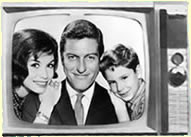 The Dick Van Dyke Show:
The Dick Van Dyke Show:
Laura, Rob, and Richie Petrie
- Muriel Cantor describes the sitcom as a “world of isolated
households” (215), and to some extent, the study of sitcoms
seems to be a world of an isolated genre. Williams cites the antecedent
of
the sitcom as the variety sketch, undoubtedly its most immediate precedent.
The Honeymooners (1955–56, and #3 in the TV Guide
Top 50) originated as a skit series in the variety show Cavalcade
of Stars (1950), and even as late as 1983, the “Family”
skits from The Carol Burnett Show spun off into a sitcom, Mama’s
Family. Sid Caesar’s variety shows in the early 1950s also
featured recurring skits about young married couples in New York
grouped
together as “The Commuters”—two of the actors, Carl
Reiner and Howard Morris, would play significant behind-the-scenes
roles
in The Dick Van Dyke Show. While the skits were separate from
the musical numbers on variety shows, the interspersion of comedy
with
music and other kinds of performance (and commercials) established
a rhythm that resonates with musical comedy films—as well as
the common antecedent of both musical comedy and variety shows, the
vaudeville
ticket.
- Not much attention is really paid to the continuity
of the sitcom with other forms of entertainment, although Eaton, in
“Television Situation Comedy,” briefly delves a little further
than Williams, drawing on the radio comedy—a clear precedent for
I Love Lucy via Lucille Ball’s stint on My Favorite
Husband4—and comedic films.
Feuer cites the sitcom as the “simplest and least cinematic”
genre on television (“Narrative” 107), while
on the merits of its “excess” of design and music and the
reliance upon a heightened suspension of disbelief (beyond that demanded
by most other narrative genres), the musical might be deemed the most
cinematic. In terms of the logic of genre, the sitcom and the musical
might seem poles apart, except for two historical contingencies—the
television sitcom arose as the Hollywood musical was reaching its peak
of popularity and aesthetic achievement in the late 1940s and early
1950s; and there was a not-insignificant crossover of creative personnel.5
- Feuer makes a distinction between genre in film and genre in television.
Film genres develop by recombining and commenting on earlier films within
the same genre; Feuer proposes that television genres have a greater
tendency to recombine across genres. She gives the example of Hill
Street Blues, which blends elements of crime show, soap opera,
and documentary (“Genre Study” 158). All her examples of
genre crossings (in fact, the vast majority of the sitcoms she discusses
in all her work) are from the late 1960s and 1970s. This historical
circumscription misses an element of earlier sitcoms that had largely
disappeared by the middle of the 1960s—particularly in the so-called
“quality television” sitcoms on which Feuer concentrates—and
did not re-emerge until the 1980s, namely the musical number. True,
the musical number is a rarer “Indian” than most, but the
musical was also the one really popular film genre that failed to make
the transition to television, largely because of its technical, cinematic
demands. Music on television was, and continues to be, primarily visual
radio (in the form of variety shows, chart shows, and music video) except
in its sitcom setting. This genre crossing, therefore, also crosses
media and falls in that disciplinary divide.
- Genre study’s main focus tends to be on narrative. The sitcom
is considered conservative in its narrative strategies because the formula
of the series—as opposed to a serial, which has a narrative trajectory
that changes from episode to episode—relies heavily on repetition.
Eaton states that “nothing that has happened in the narrative
of the previous week must destroy or even complicate the way the situation
is grounded,” and hypothesizes an inside/outside dichotomy to
the situation. Any foreign character or plot line must be expelled by
the end of the episode:
In its least complicated manifestations, events from the outside can be allowed to enter the situation to provide for a weekly narrative development, but these events/characters have to be dealt with in such a way that the parameters of the situation are ultimately unaffected by either their entry or expulsion so that the situation can be maintained and taken up again the following week. (Eaton, “Television” 33)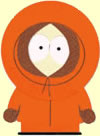 Kenny from South Park
Kenny from South Park
“Forgetting” is an intrinsic part of playing the narrative’s episodic game. The animated series South Park carries this to its parodic extreme: every week, the snow-suit clad Kenny meets a different violent end (“Oh, my God! They’ve killed Kenny!” is the catchphrase of the series), but he always manages to be waiting for the school bus with the others at the beginning of the next episode.
- The sitcom is also widely considered conservative politically and
socially (see Eaton and Cantor for instance). Due to the pressure of
delivering to large audiences of the right demographic profile, sitcoms
display mainstream, middle-class values, particularly as they impinge
on structures of the family and the
concomitant gender and sex roles.6 Historically,
political and social concerns have tended to be ignored or addressed
obliquely. For instance, the anxiety of white, middle-class men over
the growing women’s movement in the 1960s explains the presence
of not just one, but two, magical women who are constantly forbidden
to use their extraordinary powers by their male partners Bewitched,
I Dream of Jeannie); and as Cantor points out, the liberal parents
and Reaganite son of Family Ties often talked about politics,
but they rarely did anything about it (215).
-
The family provides the primary “situation” of the situation comedy. Though more recent sitcom families might be of less conventional construction than the traditional nuclear family (My Two Dads, Kate & Allie, Perfect Strangers, Frasier, Will & Grace), or composed of a group of friends (Cheers, Friends, Seinfeld, The Drew Carey Show), or co-workers (M*A*S*H, Murphy Brown), or even a group of co-workers masquerading as an unconventional family (Third Rock from the Sun), the group dynamic reproduces that of the family.7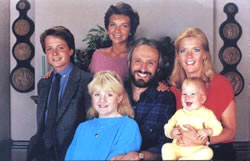 The Family of Family Ties
The Family of Family Ties
- The cyclical repetition of narrative and the stable family construct
at its center place the sitcom at odds with the musical. While the musical
often represents equally conservative social and political values, it
is narratively progressive in that it proceeds toward a goal—in
most cases, two goals, pursued by two parallel narrative drives: the
formation of the romantic couple and putting on the show, celebrated
together at the end (see Altman American Film Musical). If
the two genres are to be merged, therefore, there must be some negotiation
of the narrative strategies.
- The formation of the romantic couple is not an issue in either I
Love Lucy or The Dick Van Dyke Show, as the family unit
is already stable and ongoing—the Ricardos have been married twelve
years by the time Little Ricky is born, the Petries have a child from
the outset. Critics often cite The Dick Van Dyke Show as the
prototype of the sitcom revolving around two axes: the family and the
workplace (for instance, Eaton, “Television” 37). These
axes might be termed locations rather than situations, because Buddy
and Sally are as much eccentric uncle and maiden aunt in the family
as they are colleagues in the workplace. The dynamic of the various
characters of The Dick Van Dyke Show is that of an extended
family, whether they are at work or at the Petrie home; the business
of “work” is often brought into the Petrie living room,
with Laura directly or indirectly participating in the putting on of
the show, blurring the distinction between the two situations (making
it one, bigger “situation”) and merely deploying it in two
different spaces (“locations”). However, I Love Lucy
has a similar, if less balanced, polarity between the Ricardos’
apartment and Ricky’s nightclub—the club is seen less often
than the writers’ room at The Alan Brady Show, but this
has the effect of making the club a more enticing goal, a glamorous
grotto far more appealing than a dingy office, even one that is often
the scene of inspired performance.
- Ticking along behind the foreground story in both series is the activity of show business, of literally putting on a show. In both I Love Lucy and The Dick Van Dyke Show, the narrative negotiation between the sitcom and the musical is accomplished through the type of show mounted. In the first instance, a nightclub act which goes on nightly but changes periodically, and in the second, a weekly television variety show in which the details change (a different song, a different performer, a different novelty act, a different skit), but the overall shape of the show is the same—though popular acts or skit characters could be repeated. Despite the necessary variation to provide stimulation and entertainment, at the generic level the shows themselves are like sitcoms, repetitive and cyclical.
- In order for the narrative to return to its initial situation, the
musical number in a sitcom cannot offer the same effect of “progress”
(toward the building of the show, toward the formation of the couple
relationship) that it does in a musical film. I Love Lucy and
The Dick Van Dyke Show found different solutions to the problem.
- In I Love Lucy, Lucy could never actually
be good enough to be in the show, or if she did manage to wangle her
way on stage, her performance could not be successful—at least
in the way she intended it—because that would defuse the basic
premise of the sitcom. If she were good, then it would make it very
difficult to explain why she was not then in the show on a regular basis.
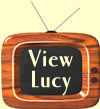 Of
course, this would disrupt the patriarchal family construct of the sitcom,
removing the woman from her position of housewife.8
In fact, Alexander Doty notes that some of the early performance moments
were not unsuccessful, strengthening the need for Lucy’s increasing
domesticization—to make it even more impossible for her to move
outside the home. This domestic drive places I
Love Lucy in opposition to the narrative structure of the musical,
which usually implies that the woman’s career will continue after
the assumed marriage.9 The musical number
is a goal towards which Lucy aspires, and the gap between her ability
and her desire is the direct and indirect basis for much of the comedy.
Of
course, this would disrupt the patriarchal family construct of the sitcom,
removing the woman from her position of housewife.8
In fact, Alexander Doty notes that some of the early performance moments
were not unsuccessful, strengthening the need for Lucy’s increasing
domesticization—to make it even more impossible for her to move
outside the home. This domestic drive places I
Love Lucy in opposition to the narrative structure of the musical,
which usually implies that the woman’s career will continue after
the assumed marriage.9 The musical number
is a goal towards which Lucy aspires, and the gap between her ability
and her desire is the direct and indirect basis for much of the comedy.
- Although the musical number is less central to the narrative drive,
The Dick Van Dyke Show contains a greater variety of musical
performances, most of which emerge from the narrative as if in a classical
Hollywood musical, with its paradoxical celebration of entertainment
as “work” that is easily accomplished by the talented—at
a distance. The Dick Van Dyke Show accomplishes this distancing
in two ways. The first is the deferment of professionalism by emphasizing
preparation and amateur participation: the variety show on which Rob
Petrie works, The Alan Brady Show, is seen even less than the
club is seen on I Love Lucy. With the exception of an obviously
aberrant Christmas special (“The Alan Brady Show Presents”),
the main characters never appear on the show, nor do we ever see Alan
Brady perform. (Even in the Christmas special, his participation is
limited to that of master of ceremonies). Musical numbers are framed
as rehearsals, the working out of sketches, or performances wholly unrelated
to the television show, such as charity gigs, parties, or amateur dramatics—the
only situation in which professionalism is reasserted, in the face of
monumental incompetence. The Petries are shown to be far and away the
best performers in the local PTA, though one episode does center on
Laura’s surprise and jealousy at the arrival of an equally lovely
and talented performer (“Too Many Stars”).
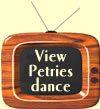
- The second method of distancing the musical number was in the show’s
innovative structure, incorporating flashbacks that detailed the Petries’
rocky courtship. This technique reasserts the musical’s dual narrative
strategy of show- and couple-formation.
- The leading couples are not the only musical characters: both programs
often showcased the performances of guest stars, appearing either as
themselves or thinly veiled fictionalizations of themselves (for instance,
singer Vic Damone appears as Rick Vallone in The Dick Van Dyke Show
episode “Like a Sister”). The second leads in both series
also have show-business pedigrees: Fred and Ethel Mertz occasionally
trot out the old vaudeville act in I Love Lucy; Buddy Sorrel
and Sally Rogers were also vaudevillians, as well as radio writers and
performers.
- All the characters in The Dick Van Dyke Show are content
in their current domestic and professional roles, though all of them
(with the exception of the most successful one, Rob Petrie) are given
opportunities for a “what-if” exploration of other possibilities
that nonetheless reinscribe their positions in the show’s overriding
narrative. In “The Secret Life of Buddy and Sally,” Rob
and Laura become suspicious of Buddy and Sally’s behavior;
they think they are having an affair. In fact the two are performing
weekends
at a small Borscht-belt nightclub. They do not aspire to anything more
than the modest success they enjoy in the club; in fact, they
have kept
their performing a secret because they fear their showbiz friends will
misunderstand and pity them, thinking them unable to progress
beyond
the decidedly old-fashioned (even deliberately corny) vaudeville act.
Their idea of success is “domesticated”
to contentment.
- Similarly, in an early episode “To Tell or Not to Tell,” Laura is given the opportunity to fill in for an injured dancer on The Alan Brady Show and throws herself into it with great enthusiasm. However, we only “see” the results through the eyes of Rob and Richie, watching on television while we watch the back of the set—another deferment. Producer Mel Cooley tells Rob that they want to offer Laura a permanent job, unless Rob objects: a patriarchal moment if there ever was one. Rob is torn between wanting what he thinks Laura wants—a dancing career—and his own inability to cope with things at home (son Richie isn’t impressed by Rob’s cooking and even thinks that “Mommy’s bananas are better”). Finally, Rob reluctantly tells Laura about the offer; she is ecstatic because it validates all the work she has been doing, but she refuses the offer because she has proven herself and prefers being a housewife and mother.10 While complicit with any number of family sitcoms in reinforcing the idea that the woman’s place is in the home, this episode, at least partially, shows the lie that women’s work, whether entertaining or doing housework, is effortless. When Laura comes home exhausted and stiff, Rob commiserates, “I guess dancing’s rougher than housework,” but Laura refutes it: “Oh, no, nothing’s rougher than housework.”

1 2 3 4 Works Cited
![]()
*
My thanks to Rachel Moseley and Stan Hawkins for casting a critical eye
over previous drafts of this paper, Mitchell Morris as always for clarifying
discussions, and the ECHO reader whose comments allowed me to open
up elements of analysis that were slighted earlier.
1.
The analogy of Indians in Westerns and musical numbers in sitcoms is one
that has caused intense reaction among some readers and none among others.
I would like to highlight that the analogy comes from Feuer where it merely
registers presence or absence: she chooses “Indians” as her
representative example, but she could have chosen ten-gallon hats, gunslingers,
pearl-handled revolvers, or sheriffs, and the meaning would not change.
However, I realize that for many people this term and the analogy causes
some consternation and I am certainly sensitive to and aware of the dangers
of misreading the analogy. As someone whose family came off an Oklahoma
reservation within the last century, I am certainly sensitive to the history
behind the term “Indian”—yet among many individuals
and communities with which I am familiar, the identity “Indian”
(or “Indin”) is still preferred to “Native American,”
which imposes a colonial identity upon indigenous peoples that attempts
to neutralize the force of historical oppression in a way that the “misidentification”
of “Indian” continually threatens to expose. In Feuer’s
analogy regarding the Western movie, these peoples were always already
“Indians,” in the stereotyped and misrepresented sense. Only
in the most recent Westerns has any real attempt been made to redress
that unequal power representation. Ironically, perhaps the most narratively/politically
successful of these attempts was in Simon Wincer’s 1990 comedy Quigley
Down Under, in which the treatment of Australian indigenous peoples
“stands for” the genocide and relocation of the North American
“aborigines.” This reinforces, rather than negates, the power
of the metaphor.
2. Almost all the shows on the list
were newer, which strongly tends to slant such unscientific lists (i.e.,
Seinfeld was listed as “best show,” but the resonance
of that show has not yet proved as profound as these two). Significantly,
however, they both were among the oldest shows in the top 50; among their
contemporaries only The Honeymooners (#3; 1955–56)
is a sitcom. Other shows of the same vintage all rated lower and include
variety shows (The Ed Sullivan Show, #15; 1948–71, and
Your Show of Shows, #30; 1951–54); a news/entertainment show
(The Today Show, #17; 1952–present); dramatic anthologies
(The Twilight Zone, #26; 1959–64, and Playhouse 90, #33;
1956–60); and dramas (The Defenders, #31; 1961–65, Gunsmoke,
#40; 1955–75, and Bonanza, #43; 1959–73).
3. Other influential books that appeared
about the same time include Dyer, Light Entertainment and Newcomb.
4.
Several episodes of this radio program were rewritten as episodes of I
Love Lucy, and some of them can be found on the recent DVD releases
of I Love Lucy, matched with their “remakes.”
5. Doty points out the large contingent
of “non-star” performers from film, nightclub, and vaudeville
who transferred to television, though he does not explicitly make the
connection to musicals (3).
6.
Of course, there is an immediate and somewhat unavoidable danger of conflating
what the sponsor or network wants, what they perceive the audience to
want, what the audience really wants, and what seems evident that the
audience wants based on the texts of shows that continue to be popular
decades after their original run. A detailed ethnography is beyond the
scope of the present article—and is, indeed, often no longer possible
due to the contamination of reruns and the vagaries of memory—but
this difference should be kept in mind. On the other side of the equation,
Meaghan Morris pointedly warns of the danger of academics who want to
understand culture by talking to “the people,” but who then,
even with the best will in the world and the intent of empowering “the
people,” appropriate and recast those voices within the frame of
their own academic discourse. While recognizing and appreciating the complexity
of this dilemma, as academics we must also accept the occasional partial
collapse of these analytical points of view, or we will never be able
to venture into new territory.
7. The paradigm of the family sitcom
is so strong that this overrides almost every other consideration, but
it was not yet firmly set in the early 1950s. Doty discusses the increasing
domesticity of I Love Lucy—the birth of Little Ricky, the
move to suburban Connecticut near the end of the show’s run—bringing
it more in line with the family shows such as Father Knows Best
and Leave It to Beaver. This is the background against which
The Dick Van Dyke Show introduced its “revolutionary”
dual setting of home and workplace.
8. A more optimistic but still paternalistic
reading would see Ricky’s resistance to Lucy’s desire for
performance as protecting her from inevitable humiliation.
9. We are rarely taken past that
point in musicals; however, one of the few musicals that addresses the
role of the female performer after marriage, Everything I Have Is
Yours (1953—right at the height of I Love Lucy’s
run) starred the married dance duo Marge and Gower Champion. Audiences
would have been aware of their marital status, and the characters are
therefore relatively easy to elide with the stars, who it must be said
had very little in the way of personas beyond that of a married couple
who danced together. The plot revolves around the tension between the
traditional domestic role of wife and mother (the film begins as Pamela
discovers her pregnancy) and the more glamorous one of musical comedy
star, though both are shown to be hard work.
10.
The episode “My Part-Time Wife” deploys very similar arguments
when Laura volunteers to type for the writers while Sally pursues a
more
visible television career on a talk show. When Laura contributes a very
funny joke to the script, Rob is threatened. Laura has been conspiring
with the social pressures that render a woman’s work “invisible”
(see Haralovich) by doing the cooking and cleaning in the middle of the
night and napping at lunchtime, none of which Rob even notices. Yet
it
is Laura who must reassure her husband that she would rather be at home,
and that she only came to work to help him. Sally returns to
the fold
when she upstages the talk show host and is fired/quits. This is an excellent
example of returning the narrative to a state of equilibrium—both
women have been displaced and both must be brought back to their original
places.
| |
|
Articles
|
|
Stilwell: The Musical Number and the Sitcom Al-Taee: Politics, Identity, and Sexual Narrative in Algerian Rai |
|
Interview
|
|
Review Essays
|
|
Reviews
|
| |
|
Conference Report
|
|
|


